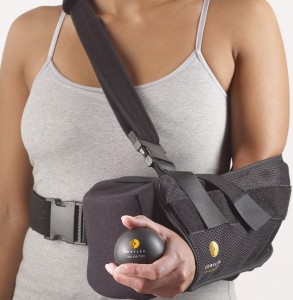By Matthew Stiebel, MD, FRCSC –
 A recent trend has struck many of the shopping malls of South Florida: large numbers of patrons with arms in slings. As you travel the escalators or walk the rows of the parking lot, it’s easy to be struck by the sheer number of people in slings and shoulder immobilizers. “What is meaning of this strange trend in immobilization?” “Has Louis Vuitton or Gucci released a new line of arm hanging wear?” The answer is, of course, “No,… these trendsetters have just recently undergone rotator cuff surgery”
A recent trend has struck many of the shopping malls of South Florida: large numbers of patrons with arms in slings. As you travel the escalators or walk the rows of the parking lot, it’s easy to be struck by the sheer number of people in slings and shoulder immobilizers. “What is meaning of this strange trend in immobilization?” “Has Louis Vuitton or Gucci released a new line of arm hanging wear?” The answer is, of course, “No,… these trendsetters have just recently undergone rotator cuff surgery”
“What is a rotator cuff tear and how do I know if I have one?”
One way to think about the muscles of the shoulder is to envision a layer cake. On the outermost layer resides the big, almond shaped deltoid muscle that swimmers and body builders strive so hard to aesthetically perfect. Underneath these big deltoids lie the smaller muscles, the ones that let you control your arm over your head– the muscles of the rotator cuff. These smaller muscles take a lifetime of rubbing and abuse (just think about how often you move your arms on a daily basis) and eventually begin to wear out. When these muscles wear, they begin to tear free from their attachment sites on the proximal humerus—not unlike the way the rubber belts in our cars begin to crack and age at 100k miles. If these rotator cuff muscles fully tear away from their attachment sites, it can be difficult and painful to use your arm above your head. Most patients complain of chronic shoulder pain, worse when trying to do overhead activities. Also, they note that sleeping on their affected shoulder becomes very difficult due to the pain. Diagnosis of a cuff tear should be performed by a proper physical exam and can be confirmed with a MRI test.
“How do doctors fix rotator cuff tears?”
In the modern age of orthopaedic surgery, most rotator cuff tears are fixed with small bone anchors attached to heavy sutures. These sutures are woven through the muscles/tendons of the rotator cuff in specialized patters and work to tightly pin the tendons back down to their normal bone attachments. Because the humerus bone and the muscles/ tendons of the rotator cuff are alive, the sutures just hold the two entities near each other while they grow back together.
This is much the same way that an arborist ties tree branches together to get them to grow into one entity. (It’s no accident that the symbol for orthopaedic surgery is a tree tied around a stake.) Additionally, most repairs can be done minimally invasively with the use of an arthroscopic camera. This greatly reduces the recovery period, as that outer layer of the shoulder (the deltoid) does not have to be cut open to get down to the deeper torn cuff muscles.
“Who should I see if I think I might have
a rotator cuff tear?”
Just like not all teachers or baseball players are equivalent, not all orthopaedic surgeons are equal when it comes to arthroscopic rotator cuff repair. Because it can be a fairly technically demanding surgery, one way to try and decide which doctor might give you the best outcome is to look and see if that surgeon has done an accredited sports or upper extremity fellowship. A fellowship is an extra year of training specifically focused on arthroscopic repairs. Additionally, many surgeons interested in arthroscopy are published authors, or are contributing members of specialized arthroscopic or orthopaedic sports societies dedicated to teaching and research in the field of shoulder surgery.
So, the next time you see someone wandering about town with their arm wrapped up in one of those fancy sling immobilizers, they might just be fresh from their 100k mile tune-up. Perhaps they had their rotator cuff arthroscopically repaired, and are patiently waiting for the regrowth of that tendon back into its humeral bone attachment? Louis Vuitton eat your heart out…
Matthew Stiebel, M.D. FRCSC
Board Certified, Fellowship Trained Orthopaedic Surgeon Matthew Stiebel, MD FRCSC, is the newest partner at Palm Beach Sportsmedicine. After un-
dergraduate and medical school degrees at Yale University, he completed an orthopaedic surgery residency at McGill University and a subspecialty fellowship in sports medicine at Boston University. His specialties include complex shoulder and knee injuries. Dr Stiebel has published papers and book chapters on specialty surgeries of the knee and shoulder. He is an associate master instructor for the Arthroscopy Asscociation of North America, where he instructs both arthrocopic shoulder and patellofemoral knee courses for surgeons in the US and internationally. He has lectured to the International Patellofemoral Reseach Group in London and New York City, and has worked with patellofemoral implant design companies. His other current interest involves the repair of pectoralis major muscle tears and their subsequent outcomes. While in Montreal, Dr Stiebel worked with the Montreal Canadians Hockey team and Expos Baseball team. During his fellowship time in Boston he was able to serve as team physician for the NCAA championship BU men’s hockey team, UMASS Boston Hockey, as well as work with the World Wrestling Entertainment Summer Slam Series. Locally, Dr Stiebel stays active in the community by currently serving as team physician for some of the local high school football and gymnastics programs.
Certificates/Memberships:
– Board Certification: American Board of Orthopaedic Surgery, July 2012
– American Academy of Orthopaedic Surgeons
– Fellow, Royal College of Physicians and Surgeons of Canada American Arthroscopy Association of North America
– International Society of Arthrosocopy, Knee Surgery & Orthopaedic Sports Medicine
– International Patellofemoral Reseach Group
Palm Beach Sport Medicine
(561) 845-6000
www.pbsportsmed.com
Check Also
Physical Therapy for the Brain
Have you noticed you have difficulty hearing your family and friends in a noisy restaurant? …
 South Florida Health and Wellness Magazine Health and Wellness Articles
South Florida Health and Wellness Magazine Health and Wellness Articles




